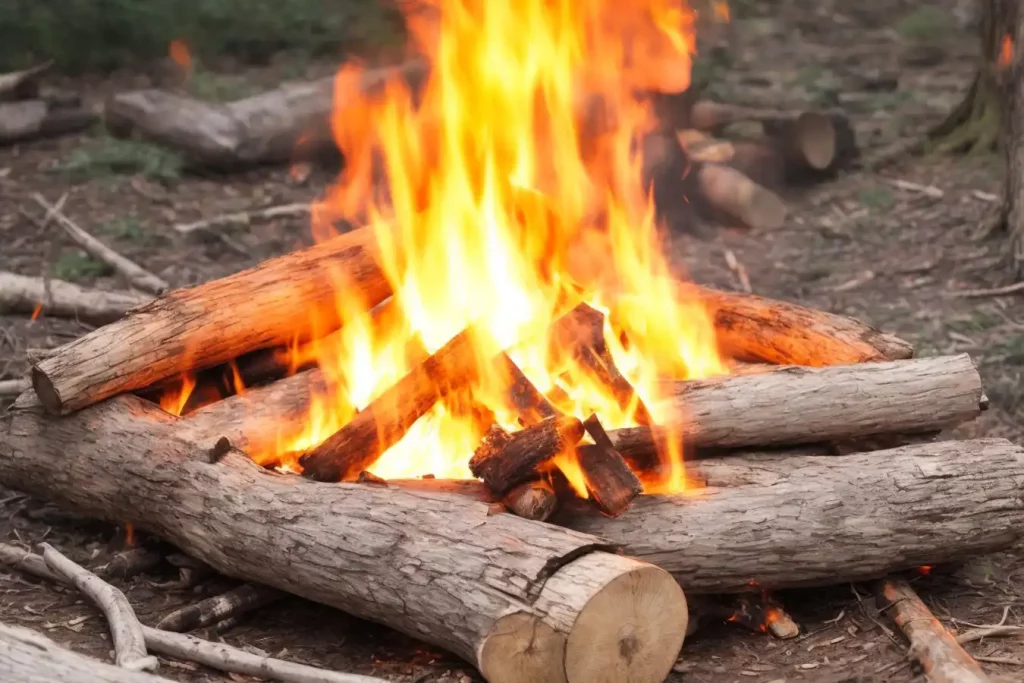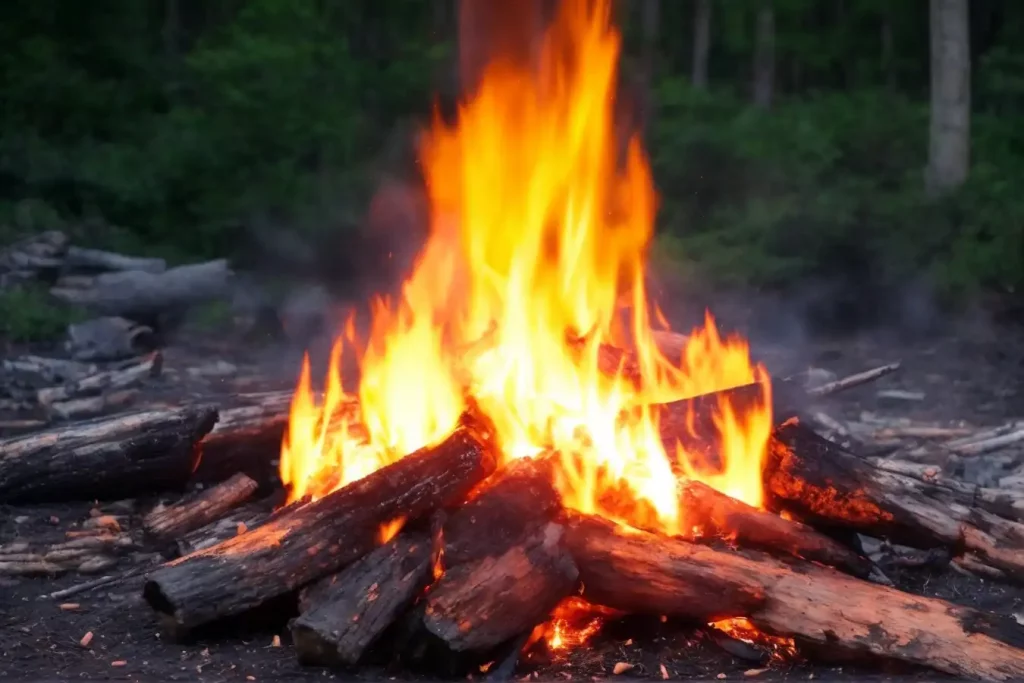How hot is a camp fire, you ask? Well, you’ve landed in the perfect spot to find out!
Look, whether you’re a camping newbie or a seasoned wilderness explorer, understanding the heat of your campfire is essential.
It’s not just about cooking the perfect s’more—although, let’s be honest, that’s crucial too!
Knowing the temperature can keep you safe, help you cook like a campfire gourmet, and even make you the go-to fire guru on your next outdoor adventure.
So grab a comfy seat by the flame, because we’re about to get into the sizzling science and nitty-gritty of campfire temps!
What Makes a Fire Hot: A Quick Science Lesson
Let me take you back to high school science class for a moment—but I promise to make it interesting. Fire is more than just burning wood; it’s a fascinating combination of chemistry and physics at work. Knowing a bit about what makes a fire hot can also help you become the ultimate campfire guru. 🏕️🔥
What’s in a Flame?
You look at a flame, and you see orange, yellow, maybe a bit of blue at the bottom, right? But what you’re really looking at is a cocktail of heat, light, and gases all reacting in real-time. Here’s the gist:
- Fuel: That’s your wood, leaves, or whatever you’re burning. Let’s call it the “starter pack” of your fire.
- Oxygen: Fires need to breathe, just like us. Oxygen in the air helps the fire sustain itself.
- Heat: This is where the magic happens. Heat helps break down the fuel, and that releases gases.
The gases released combine with oxygen, and BOOM! You have combustion. The heat generated can be anywhere from 600°F to around 2000°F, depending on the type of wood and how well-oxygenated the fire is.
Ever seen different colors in a fire? That’s actually telling you something about its temperature. Blues and whites are hotter (usually around the 2000°F range), while reds and oranges are cooler, closer to 600-800°F.
When you’re cooking over a campfire, knowing these heat levels is golden. Cooking your catch-of-the-day trout? Aim for the blueish flame. Perfect marshmallow? Stick to the red-orange zone for that ideal slow roast.
There you have it, folks—the down and dirty on campfire temperatures. It’s not just a pile of burning wood; it’s a well-oiled, heat-generating machine.
Answering the Burning Question: How Hot is a Camp fire?
Ever wondered how hot is a campfire when you’re toasting those marshmallows? A typical campfire can burn at temperatures up to 2,000 degrees Fahrenheit (1,093 degrees Celsius), but the heat can vary depending on factors like wood type and weather conditions. Quite the range, right?
Let’s dig a bit deeper into how you can measure this yourself, and what variables can make your campfire hotter or cooler.
Measuring a Campfire’s Temperature
Okay, first things first. If you’re planning on measuring a campfire’s temperature, remember: Safety first! Always have water or a fire extinguisher nearby in case things go south.
Now, here are the tools you can use:
- Infrared Thermometer: This gadget allows you to measure the heat from a safe distance. Just point, click, and there’s your reading.
- Thermocouples: These are a bit more precise but also more involved. Thermocouples are tiny devices made of two different metals that can measure temperature accurately. You’d need to place them in the fire and connect them to a reader. Not really for casual campers, but hey, if you’re into the nitty-gritty, why not?
- Your Hand: Now, this isn’t scientific, but the back-of-the-hand test can give you a rough idea. Hold your hand about a foot above the flames. If you can’t keep it there for more than a few seconds, it’s probably too hot for cooking but perfect for boiling water.
Campfire Temperature Ranges
Alright, here’s the tea—or should I say, the hot cocoa? A typical wood-fueled campfire, well-fed with oxygen, will range between:
- 600°F to 900°F (315°C to 482°C): This is usually the orange and red parts of the flame. Great for roasting marshmallows or hot dogs.
- 1100°F to 1500°F (593°C to 815°C): This is where you hit yellow flames. You can sear some meats here, no problem.
- Up to 2000°F (1093°C): Now you’re in the blue and white flame territory. Super hot, and usually found at the base of the fire. Boiling water? This is your zone.
Factors That Can Change a Campfire’s Temperature
Knowing how hot a campfire gets is great, but understanding the variables that can impact this heat is like unlocking a secret level in a video game. Let’s break it down.

Types of Wood
Not all wood is created equal, my friends. Softwoods like pine and spruce burn faster and at lower temperatures. But hardwoods like oak and maple? They’re the real MVPs, burning longer and hotter. If you want a fire that roars, go for hardwoods. If you’re looking for something more temporary, softwoods will do the trick.
Oxygen and Environment
Here comes our buddy oxygen again, alongside some other factors:
- Airflow: A well-ventilated fire is a happy fire. Keep space between the logs to allow oxygen in.
- Wind: A light breeze can help fan the flames, but too much wind? You might find yourself with a fire that’s burning hotter and faster than you’d like.
- Humidity: Moist air can dampen your fire’s enthusiasm. Literally. You’ll need to work harder to get a higher temperature.
- Altitude: Yep, the higher you go, the lower the boiling point of water, which means your fire’s heat could behave differently.
Hope you found these insights hot (pun totally intended)! There’s always more to learn, so stay tuned for more campfire wisdom. 🏕️🔥
Why Does Campfire Temperature Matter Anyway?
So you might be wondering, “Who cares about campfire temps, as long as I’m warm and my s’mores are gooey?” Well, hold onto your marshmallow sticks, because it’s not that simple.
Safety Considerations
First off, safety! Knowing how hot your fire is can be a real game-changer. Let’s say you’re using an infrared thermometer and the reading is off the charts. That’s a fire getting a little too excited, and a super hot fire can be tough to control. The last thing you want is to be that guy who started a forest fire because you didn’t know your campfire was hot enough to, I don’t know, melt steel. Be aware, be safe.
Cooking Over a Campfire
Next, let’s talk grub. Cooking over a campfire isn’t just slapping a hot dog on a stick and calling it a day (although, hey, no judgment if that’s your style). Different foods need different temps. Want to roast a perfect marshmallow? You’re looking for those cooler, orange and red flames. Aiming for a juicy steak? Those hotter yellow flames will serve you well. Knowing your fire’s temperature can take your campfire chef skills from amateur to artisan.
Common Myths About Fire Temperature
Ah, myths—the saucy gossip of the natural world. Let’s set the record straight.
- Blue Fire is the Hottest: This one’s sort of true but needs clarification. Blue fire is hotter than yellow or red, but guess what? It’s not the hottest. The inner core of the fire can actually get hotter than those blue flames you’re seeing.
- All Wood Burns the Same: If you’ve been paying attention, you know this one’s baloney. Softwoods and hardwoods have different burning temps, and even among hardwoods, the temps can vary. So no, one log does not fit all.
- Fires Burn Hotter at Night: Sounds romantic, but sorry, no dice. The temperature of a fire doesn’t magically go up when the sun goes down. What changes is your perception of the heat because the ambient temperature drops.
- More Fuel Equals a Hotter Fire: This is a tricky one. More fuel does mean a longer-lasting fire, but it doesn’t necessarily mean a hotter one. In fact, stuffing your fire with too much wood can choke the oxygen flow, making it burn cooler.
Sure thing! How hot is a campfire really becomes a crucial question when you’re out in the wilderness, relying on it for warmth, cooking, and those ever-essential s’mores! 🏕️🔥
FAQs about How Hot is a Camp Fire
How hot can a campfire be?
A campfire can reach up to 2,000 degrees Fahrenheit (1,093 degrees Celsius) if conditions are right. But keep in mind, this isn't your average family outing campfire; we're talking max heat here.
What degrees is a campfire?
In a typical scenario, you can expect your friendly neighborhood campfire to be around 930 degrees Fahrenheit (about 500 degrees Celsius). Ideal for roasting those marshmallows!
What is the hottest part of a campfire?
So, you're after the hot spots, eh? The hottest part of a campfire is actually just above the logs, in the middle of the flames. You might think it's the blue flame, but remember, appearances can be deceiving!
How hot is a basic fire?
A "basic" fire, like the kind you'd whip up for a little warmth or cooking, usually hangs around 600 to 800 degrees Fahrenheit (316 to 427 degrees Celsius). Think of it as the "just right" zone for most of your campfire needs.
Summary
Alright, folks, as we pull this campfire chat to a close, let’s get real for a second. Understanding your campfire’s temperature isn’t some nerdy fascination; it’s practical knowledge that can keep you safe, make your meals tastier, and debunk those fireside myths that Uncle Bob keeps spouting off every summer.
Key Takeaways
- Safety First: Knowing your campfire’s temperature can help you control the fire and avoid potential hazards. No one wants to be “that guy” who couldn’t handle his own fire.
- Chef’s Hat On: Different foods require different cooking temperatures. If you’re looking to elevate your campfire culinary skills, you gotta know your heat zones.
- Science is Cool (or Hot): Fires are more than just pretty flames; there’s some solid chemistry behind them. A better understanding can actually help you build a better fire.
- The Environment Matters: Airflow, types of wood, and even altitude can affect your fire’s temperature. So pay attention to your surroundings.
- Bust Those Myths: Not all fire myths hold up under, well, fire. Be the smartest person around the fire pit by knowing what’s what.
There you have it! Keep these tips in your back pocket the next time you’re huddled around a campfire, and you’ll be the camp’s resident fire guru in no time. Until then, may your fires be warm and your marshmallows gooey! 🏕️🔥


